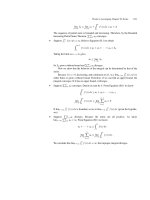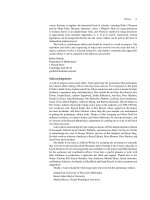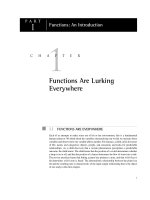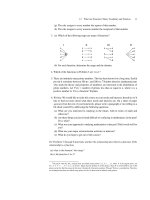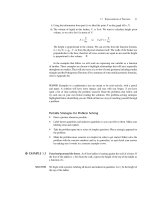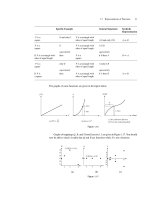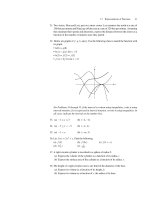Calculus: An Integrated Approach to Functions and their Rates of Change, Preliminary Edition Part 40 docx
Bạn đang xem bản rút gọn của tài liệu. Xem và tải ngay bản đầy đủ của tài liệu tại đây (315.66 KB, 10 trang )
Exploratory Problems for Chapter 10 371
21. The graph below shows the total cost and total revenue curves for a certain firm. Both
revenue and cost are functions of q, where q represents quantity.
Profit = Total Revenue − Total Cost = R(q) − C(q)
$
quantity
R
C
F
Q
1
Q
2
Q
3
Q
4
(a) Draw a graph of profit against quantity, labeling the points Q
1
, Q
2
, Q
3
, and Q
4
.
(b) What do the quantities Q
1
, Q
2
, Q
3
, andQ
4
mean as far as the profits are con-
cerned?
(c) Is the slope of the revenue curve constant or does it vary with q? Interpret the slope
of the revenue curve in terms of the economic model. Economists call the slope of
the revenue curve the marginal revenue.
(d) Is the slope of the cost curve constant or does it vary with q? Interpret the slope of
the cost curve in words. Economists call the slope of the cost curve the marginal
cost.
(e) Draw a set of axes with the vertical axis labeled $/item and the horizontal axis
labeled q, for quantity (items produced and sold). On this set of axes, sketch both
R
(q) and C
(q).
(f) Verify by looking at the accompanying graph that profit is a maximum (or a
minimum) when the slope of the cost curve is equal to the slope of the revenue
curve. How does this follow from the first derivative test?
(g) Bonus (especially for those interested in economics): Explain in words why it
makes sense in economic terms that profit is a maximum (or a minimum) when
the slope of the cost curve is equal to the slope of the revenue curve.
11
CHAPTER
APortrait of Polynomials
and Rational Functions
Linear functions, quadratics, and cubics are all members of the larger family of polynomial
functions, a family whose members are functions that can be written in the form
f(x)=a
0
+a
1
x +a
2
x
2
+···+a
n
x
n
,
where a
0
, a
1
, a
2
, ,a
n
are all constants and the exponents of the variable are nonnegative
integers. We have already looked carefully at linear and quadratic functions; in this chapter
we will look at characteristics of higher-degree polynomials so that we know what to expect
of them. We’ll begin with a case study of cubics both because we have run into cubics several
times in the previous chapter and because familiarity with the behavior of cubics gives us
insight into the behavior of the larger family of polynomials.
We will then turn briefly to look at rational functions, a larger class of functions that
includes polynomials as well as some wilder relatives.
11.1 A PORTRAIT OF CUBICS FROM A CALCULUS
PERSPECTIVE
A function f(x)is cubic if it can be expressed in the form
f(x)=ax
3
+ bx
2
+ cx + d,
where a, b, c, and d are constants and a = 0. If f(x)=ax
3
+ bx
2
+ cx + d, then f
(x) =
3ax
2
+ 2bx + c.
◆
EXAMPLE 11.1 Differentiate the functions below. Look at the relationship between the graphs of the
derivatives and those of the corresponding function.
(a) f(x)=
x
3
3
− 2x
2
+ 3x + 2 (b) g(x) =
−x
3
− 6x + π
2
3
373
374 CHAPTER 11 A Portrait of Polynomials and Rational Functions
SOLUTION (a) f
(x) = x
2
− 4x + 3
(b) Rewrite: g(x ) =−
1
3
x
3
− 2x +
π
2
3
,sog
(x) =−x
2
−2.
The derivative of any cubic is a quadratic, so we can use our knowledge of quadratics to aid
in sketching cubics.
1 2 3
45
1
2
3
(2, –1)
x
y
(a) f ′(x) = x
2
– 4x + 3 = (x – 3)(x –1)
f ′(x)
x
y
(b) g′(x) = –x
2
– 2
g′(x)
–1–2 1 2 3
–1
–2
–3
–4
1
Figure 11.1
x
y
2
1
12
(a)
3
3
examples of cubics
with derivative f′
the dotted line indicates
the cubic corresponding
to f(x) = –2x
2
+ 3x + 2
x
3
13
+ – +
graph of f
sign of f′
f ″(x) = 2 x – 4 = 2(x – 2)
2
– +
graph of f
sign of f ″
concave down concave up
f ′ decreasing f ′ increasing
x
y
π
2
3
3
the dotted line indicates
the cubic corresponding
to g(x) =
examples of cubics
with derivative g′
–x
3
–6x + π
2
(b)
–
graph of g
sign of g′
g″(x) = –2x
0
–+
graph of g
sign of g″
concave down concave up
g′ increasing g′ decreasing
Figure 11.2
Notice that these are families of cubic graphs. To pick a particular cubic when we only
know its derivative, we must also be given another identifying piece of information, such
as a point on the graph of the cubic. ◆
11.1 A Portrait of Cubics from a Calculus Perspective 375
Basic Characteristics of the Cubic Function f
Question: How many critical points can a cubic have?
Answer: The critical points of a cubic are the stationary points (i.e., wherever the derivative
is zero). There are no other critical points, because f
is always defined and the natural
domain of f is (−∞, ∞). The derivative of a cubic is a quadratic; a quadratic equation has
either zero, one, or two real roots, so a cubic has either zero, one, or two critical points.
cubic with zero critical points cubic with one critical point cubic with two critical points
f′(x)
f(x)
y
y
x
(a)
y
x
f′(x)
f(x)
y
(b)
y
y
x
f′(x)
f(x)
(c)
Figure 11.3
Question: How many turning points (local extrema) can a cubic have?
Answer: A continuous function f(x)has a turning point wherever f
(x) changes sign. The
derivative of a cubic is a quadratic; we need to ask how many times a quadratic can change
sign. (Think about this. Draw some parabolas, or look at those in Figure 11.3.) The answer
is zero times or two times. Therefore a cubic can have either no turning points (as in Figures
11.3a and 11.3b), or two turning points (as in Figure 11.3c), but not one turning point.
EXERCISE 11.1
(a) Find the point of inflection of f(x)=
x
3
3
− 2x
2
+ 3x + 2. (This is the function from
Example 11.1a.)
(b) Show that the point of inflection lies midway between the local maximum and local
minimum points of f . (By “point” we are referring to the x-coordinate.)
Answers are provided at the end of the section.
376 CHAPTER 11 A Portrait of Polynomials and Rational Functions
EXERCISE 11.2
(a) How many inflection points (changes of concavity) does a cubic have?
(b) In Exercise 11.1 you found that the x-coordinate of the point of inflection lay midway
between the x -coordinates of the turning points. If a cubic has two turning points, will
this always be true? If yes, give a convincing argument. If no, give a counterexample.
Answers are provided at the end of the section.
Question: What is the long-term behavior of a cubic? In other words, if f(x) is a cubic,
what are lim
x→∞
f(x)and lim
x→−∞
f(x)?
Answer: Look at the cubic f(x)=ax
3
+ bx
2
+ cx + d . When x is large enough in mag-
nitude, the ax
3
term dominates the expression. By this we mean that it overpowers all the
other terms. Therefore,
if a>0,then lim
x→∞
f(x)=∞and lim
x→−∞
f(x)=−∞,while
if a<0,we have lim
x→∞
f(x)=−∞and lim
x→−∞
f(x)=∞.
a > 0
or
(a)
a < 0
or
(b)
Figure 11.4
EXERCISE 11.3 Answer the question above basing your argument on f
(x) rather than on the dominance
of the x
3
term.
Question: How many real roots can a cubic equation have? Equivalently, how many x-
intercepts can a cubic function have?
Answer: By looking at the long-term behavior of f(x)in Figure 11.4, we see that a cubic
must cross the x-axis somewhere because it is a continuous function. Therefore a cubic must
always have at least one zero. Furthermore, a cubic can have at most two turning points, so
it can have at most three x-intercepts, because it must turn at least once in between each
two intercepts. A cubic can have either one, two, or three x-intercepts, as the graphs below
illustrate.
11.1 A Portrait of Cubics from a Calculus Perspective 377
y
x
y
x
y
x
y
x
f(x)
f(x)
f(x) f(x)
0 turning points 2 turning points
one x-intercept
2 turning points 2 turning points
two x-intercepts three x-intercepts
Figure 11.5
Question: What does the derivative tell us about where the zeros are?
Answer: Very little. The derivative tells us only about the slope of the graph of f(x).For
example, the functions in Figure 11.2(a) all have the same derivative, but the number and
location of their zeros are completely different.
Answers to Selected Exercises
Answers to Exercise 1.1
(a) x = 2
(b) local maximum at x = 1; local minimum at x = 3
Answers to Exercise 1.2
(a) one
(b) The point of inflection corresponds to the vertex of the parabola given by f
. The local
extrema correspond to the two x-intercepts of the parabola given by f
. The vertex of
the parabola is midway between these two roots.
PROBLEMS FOR SECTION 11.1
For Problems 1 through 7, give an example of a cubic function f(x) with the char-
acteristic(s) specified. Your answer should be a formula, but a picture will be helpful.
There may be many possible answers.
1. f(x)has zeros at x =−2, x = 3, and x = 0.
2. f(x)has zeros at x =−1and x = 2 only. f(0)= 1.
3. f(x)has only one zero. It is at x = 1. lim
x→∞
f(x)=−∞.
4. f has a local maximum at x = 0 and a local minimum at x = 2.
5. f has a point of inflection at x = 1.
378 CHAPTER 11 A Portrait of Polynomials and Rational Functions
6. f is always increasing.
7. f is always decreasing. f(3)=0and f(0)=2.
8. Let f(x)=(x − a )(x − b)
2
, where a>b>0.By looking at the sign of f you can
show that f has a local maximum at x = b. This problem asks you to verify this using
the second derivative test.
(a) Using the Product Rule, show f
(b) = 0.
(b) Use the second derivative test to show that f has a local maximum at x = b.
9. According to postal rules, the sum of the girth and the length of a parcel may not exceed
108 inches. What is the largest possible volume of a rectangular parcel with a square
girth? (“Girth” means the distance around something. A person with a large girth needs
a big belt.)
10. An open box with a rectangular base is to be constructed from a rectangular piece of
cardboard 16 inches wide and 21 inches long by cutting a square from each corner
and then bending up the resulting sides. Let x be the length of the sides of the corner
squares. Find the value of x that will maximize the volume of the box.
11. Without using a graphing calculator, sketch the following graphs. Label all local
maxima and minima. Beside the sketch of f , draw a rough sketch of f
(x).
(a) f(x)=x(x − 3)(x + 5) (Start by looking at the x-intercepts. Then look
at the critical points.)
(b) f(x)=−2x(x − 3)(x + 5) (Conserve your energy.)
(c) f(x)=x
3
+3x
2
−9x (Start by looking at the x-intercepts. Then look
at the critical points.)
(d) f(x)=x
3
+3x
2
−9x+1 (This time the x-intercepts are difficult to find,
so don’t bother with them. Again, conserve your
energy.)
In Problems 12 through 16, find and classify all critical points.
12. (a) f(x)=x
3
−3x+1
(b) f(x)=x
3
+3x+1
13. (a) f(x)=−x
3
−3x
2
+9x+5
(b) f(x)=x
3
+3x
2
+9x+8
14. f(x)=x
3
+x
2
+x+1
15. f(x)=−2x
3
+x
2
+7
16. f(x)=x
3
+2x
2
+3x+4
11.2 Characterizing Polynomials 379
In Problems 17 throough 20, graph the function given, labeling all x-intercepts, y-
intercepts, and the x- and y-coordinates of any local maximum and minimum points.
17. f(x)=x(x +2)(x −3)
18. f(x)=x(x −2)
2
19. f(x)=x
2
(x −2)
20. f(x)=x
3
−x
2
−6x
21. Find the equation of the tangent line to y =−2x
3
+3x
2
+6x−2 at its point of
inflection.
11.2 CHARACTERIZING POLYNOMIALS
Polynomials are quite well behaved, as functions go. They involve no operations on the
variable other than addition, subtraction, and multiplication, so polynomials are defined
everywhere; there is no need to worry about negatives under radicals or zeros in the
denominators because polynomials, by definition, have no variables under square roots or
in denominators.
Recall that a polynomial function is a sum of terms of the form a
k
x
k
, where k is a
nonnegative integer. This means we can obtain a general polynomial by adding up functions
of the form x
k
for various integer values of k, giving them different weights by multiplying
each x
k
by some constant a
k
. The result is an expression of the form
a
0
+ a
1
x +a
2
x
2
+ a
3
x
3
+···+a
n
x
n
, where a
0
, a
1
, a
2
, ,a
n
are constants, and a
n
= 0.
We call the constant a
k
the coefficient of the x
k
term. (For instance, a
3
is the coefficient
of the x
3
term.) The degree of a polynomial is the highest power to which x is raised.
(The polynomial displayed above is of degree n, because it is specified that a
n
= 0.)Ifa
polynomial is of degree n, then a
n
is called the leading coefficient.
◆
EXAMPLE 11.2 Decide whether or not the following are polynomials.
i. f(x)=4x
3
−3x+
2
x
ii. g(x) =3x
2
−7 +
√
x
iii. h(x) =
x
3
π−1
−
2
5
x
2
+ x +
1
√
8
SOLUTION
i. f(x)is not a polynomial because
2
x
= 2x
−1
has x raised to a negative power.
ii. g(x) is not a polynomial because
√
x =x
1/2
has x raised to a fractional power.
iii. h(x) is a polynomial because all the powers of x are nonnegative integers. ◆
380 CHAPTER 11 A Portrait of Polynomials and Rational Functions
Let’s start by looking at the graphs of some of the building block functions for poly-
nomials, the power functions y = x
k
, where k = 0, 1, 2, 3, 4, 5, 6.
y
x
y
x
y
x
y
x
y
x
y
x
y
x
y = x
4
y = x
5
y = x
6
y = x
3
y = x
2
y = x
1
= xy = x
0
= 1
Figure 11.6
All of the building blocks are continuous functions, and since polynomials are con-
structed as weighted sums of these building blocks, they too must be continuous.
The Zeros of a Polynomial
A polynomial equation of degree n can have at most n distinct real roots.
Suppose P(x)is a polynomial and P(x)=0 isthe corresponding polynomial equation. If
x = c is a root of the equation, then P(c)=0and (x − c) is a factor of P(x).Consequently,
if an nth degree polynomial equation has n distinct real roots c
1
, c
2
, c
3
, ,c
n
,then P(x)
can be written in the form
P(x)=k(x −c
1
)(x −c
2
)(x −c
3
) ···(x −c
n
), where k is a constant.
The polynomial
P(x)=6x
2
(x −2)(x −5)
2
(x +1)
3
is an eighth degree polynomial. We can write
P(x)=6(x −0)(x −0)(x −2)(x −5)(x −5)(x +1)(x +1)(x +1).
We say that P(x)=0has a simple root at x = 2, double roots or roots of multiplicity 2
at x =0 and x =5, and a root of multiplicity 3 at x =−1.
The polynomial
P(x)=−(x + 5)(x
2
+ 1)(x −2)
2
is a fifth degree polynomial with a zero of multiplicity 2 at x =2 and a simple zero at x =−5.
Notice that x
2
+1 is positive for all real x. x
2
+1 = 0 only if x
2
=−1, or x =±
√
−1 =±i.
If we include complex roots like these and count roots with their multiplicity, then we can
say that
a polynomial equation of degree n has exactly n roots.
